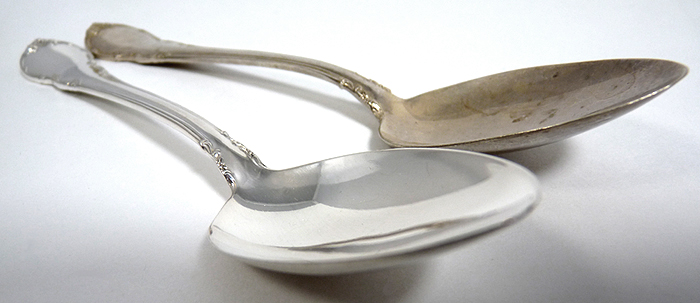|
Occasionally cleaning an object
is preferred to waiting until heavy tarnish forms and polishes have
to be employed. (All polishes have some degree of abrasion.) Before
setting your table you can catch tarnish in its earliest stage if you
hold your flatware next to a piece of white paper. If tarnish
has started to form, you will see a very light yellowish tint on the
silver. Prior to working on your flatware, if you have sensitive
hands, wear nitrile gloves – not latex which contains sulfur. WARNING:
Never put your silver in the dishwasher
or use chemical dips.
Cleaning
If you see dried polish in
ornamental areas, moisten and soften it with warm running water and
gently tap it out with a brush made of natural bristles: tampico
(soft), boar (stiffer), or horsehair (stiffest). See these brushes here.
Shorten the boar bristles if you need added stiffness. Never use a
dry brush when removing dry polish as it will create scratches.
Try removing this light tarnish
with either plant-based Better Life Dish Soap (preferred for its
neutral pH) or Dawn citrus-free dish detergent and warm water on a
cellulose sponge, then rinse under warm water and dry immediately
with a cotton hand towel, bar towel, or cotton micro-fiber cloth.
(Make sure to check the label as most micro-fiber clothes are
synthetic and may scratch, plus they are poor water absorbers). You
can also try aloe-free hand sanitizer on a cotton makeup pad or
cotton ball, then wash with one of the above dish soaps. Do not allow
the freshly cleaned flatware to touch the bottom of your sink
(possible scratching) or rubber mat (sulfur in the rubber may tarnish
your freshly cleaned silver). Place the flatware on a clean towel
until ready to store.
Polishing
If tarnish remains, use Herman's
Simply Clean Collectors Silver Polish as it leaves no residue.
Firstly, remove any signs of tarnish between tines with a flattened
Q-tip and Herman's. Continue polishing the piece with Herman's
applied to a moist cellulose sponge as it offers the gentlest
cleaning. If more pressure is required to remove more stubborn
tarnish, try Herman's on a cotton makeup pad or cotton ball (perfect
for ornamental areas) then rinse under warm water and dry
immediately. After dinner, wash your flatware by hand and place on a
clean towel until ready to store.
Gilt or partially gilt pieces
that display tarnish normally have gold that has worn away, exposing
the base metal. If this is the case use the same methods mentioned
above for silver and concentrate on removing only the tarnish.
Below: These three images are of
the same spoon handle. The left image is in its original condition;
the center image is the handle after being cleaned with hand
sanitizer; and the right image is the final finish from using silver polish.
  
Protecting Carbon Steel Components
Do you own flatware containing
carbon steel components like knife blades, fork tines, poultry
shears, or sharpening steels? This is how you can keep those
components from rusting: After dinner, hand wash the knives in warm
water, then dry immediately. Apply a very thin layer of Burt's
Bees Lip Balm and wipe with a paper towel until there is no
residue left behind. This will keep the blades from rusting. Since
this product is non-toxic there's no need to wash them prior to use.
Storage
When storing flatware, rotate the
pieces so they will wear uniformly. For flatware storage options and
resources, go here).
The above products can be found
in the Resources section of The Care
of Silver Guide.
As always, feel free to contact
me should you have any questions. |





